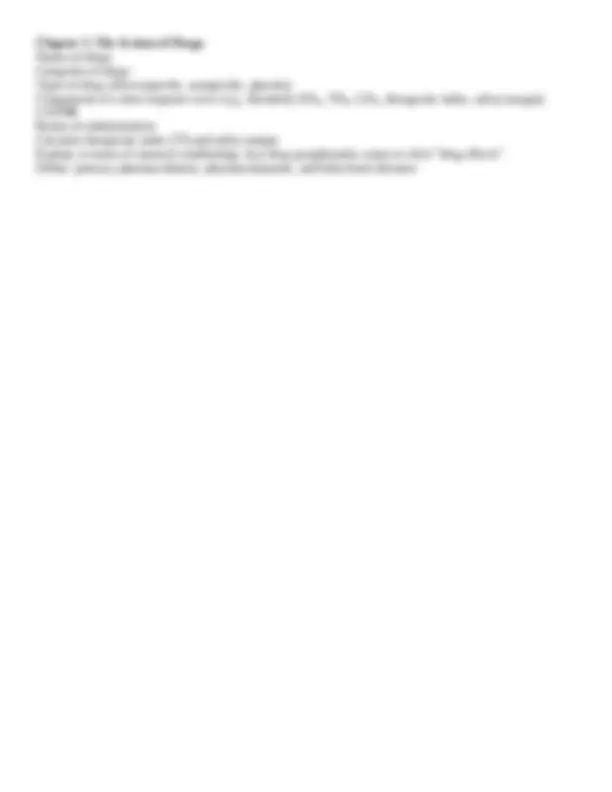



Study with the several resources on Docsity

Earn points by helping other students or get them with a premium plan


Prepare for your exams
Study with the several resources on Docsity

Earn points to download
Earn points by helping other students or get them with a premium plan
Community
Ask the community for help and clear up your study doubts
Discover the best universities in your country according to Docsity users
Free resources
Download our free guides on studying techniques, anxiety management strategies, and thesis advice from Docsity tutors
Review for Exam 2 Material Type: Notes; Professor: Nowak; Class: Int: Drgs Bhvr&Socty; Subject: Psychology; University: Wayne State University;
Typology: Study notes
1 / 2

This page cannot be seen from the preview
Don't miss anything!


Exam 1 will cover material from the text and lecture. All of the material in your textbook and from lecture is important and the more you know the better off you are. That said, here's a guide of the topics I will be addressing on the exam because I think they are key points to learn from each chapter/lecture. Chapter 1: Drug Use: An Overview Seven questions to ask when talking about drug use ("the drug problem") Four principles of psychoactive drugs (e.g., define history, expectations, set & setting) Components of a dose response curve (e.g., threshold) Correlation (negative and positive); Protective and risk factors; Antecedents Regarding Fig. 1.4 of the 14th edition (at end of lecture for Ch. 1), The greater the dependence on a drug, the more the individual factors are weighted while the societal, community, and family factors become less influential. Define: illicit, psychoactive drug, deviant drug use, drug misuse, drug abuse, drug dependence, dose response curve Chapter 2: Drug Use as a Social Problem List costs of drug use to society Three factors that influenced a shift from laissez-faire governing approach to drug use to a more controlled approach (toxicity, dependence, crime) Define and give examples of acute, chronic, behavior, and physiological toxicity (Table 2.1 from 14th edition of text is helpful) According to DSM-IV-TR, what are major differences in diagnostic criteria for substance abuse and substance dependence? Name 2 drugs with high or very high dependence potential, and 2 with low dependence potential. How do positive and negative reinforcement maintain drug use? Define: Tolerance, Physical dependence, &Psychological dependence Chapter 3: Drug Products and Their Regulations Three "issues leading to legislation" 1906 Pure Food and Drug Act Harrison Act of 1914 18th & 21st Amendments 1937 Marijuana Tax Act Narcotic Control Act of 1956 Drug Abuse Control Amendments of 1965 Comprehensive Drug Abuse Prevention & Control Act of 1970 Anti-Drug Abuse Acts of 1986 & 1988 Process of marketing new drug (preclinical, clinical - 3 phases) Two primary criteria for categorizing drugs into Schedules I - V (medical use? potential for abuse?) FDA regulates purity, safety, effectiveness. Chapter 4: The Nervous System Components of the nervous system (CNS and PNS and their subcomponents) Name 2 functions of each lobe of the brain. Sympathetic vs. Parasympathetic functions Basic structure and function of a neuron (cell body/soma, dendrites, axon, myelin sheath, presynaptic terminals) Two important functions of glial cells (myelin and blood brain barrier) Name 7 neurotransmitters commonly affected by psychoactive drugs Symptoms of hyper and hypoactivity of dopamine Lifecycle of a neurotransmitter Define: action potential, neurotransmitter, agonist, antagonist, reuptake, degradation
Chapter 5: The Actions of Drugs Names of drugs Categories of drugs Types of drug effects (specific, nonspecific, placebo) Components of a dose response curve (e.g., threshold, ED 50 , TD 50 , LD 50 , therapeutic index, safety margin) LADME Routes of administration Calculate therapeutic index (TI) and safety margin Explain, in terms of classical conditioning, how drug paraphernalia comes to elicit “drug effects”. Define: potency; pharmacokinetic, pharmacodynamic, and behavioral tolerance